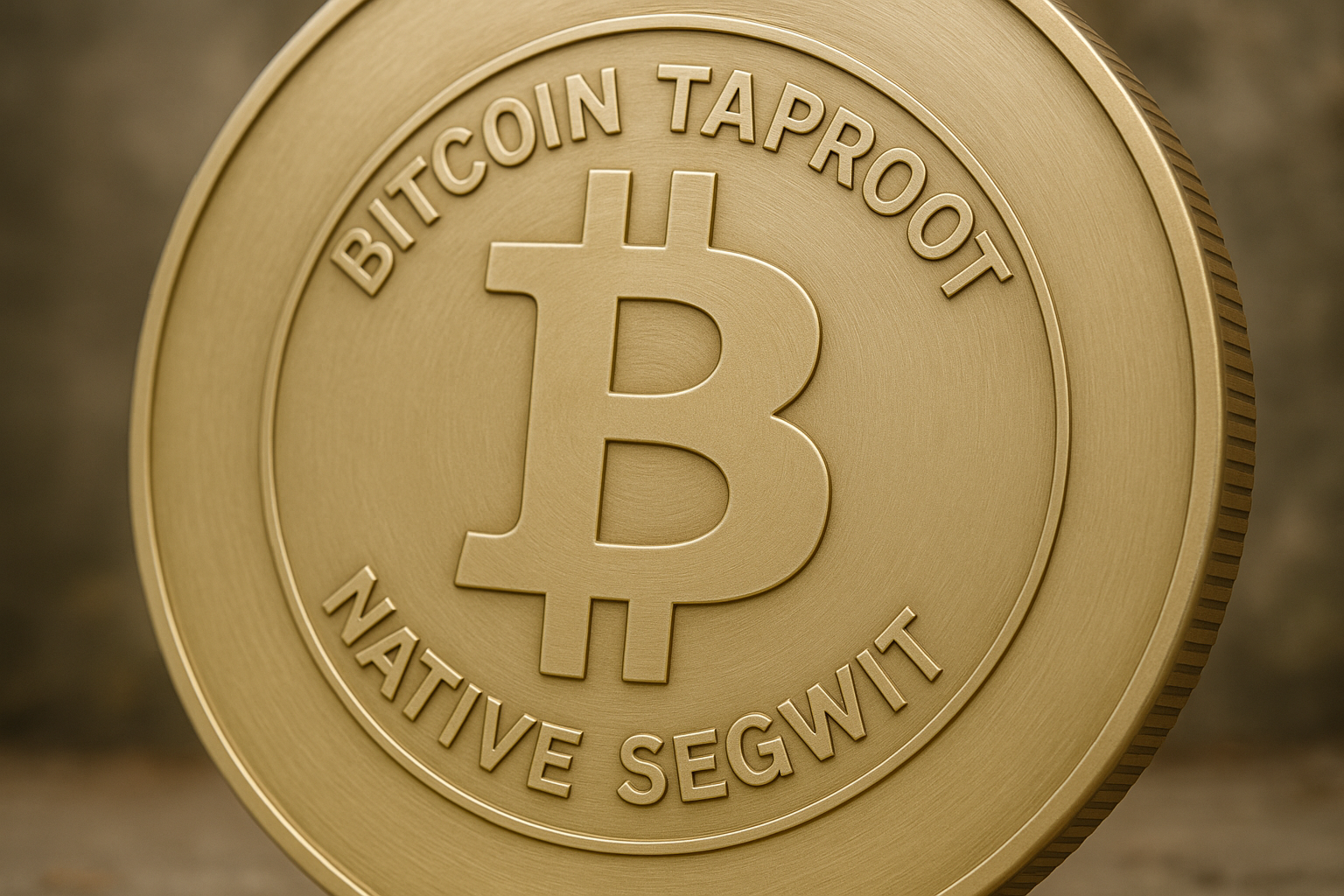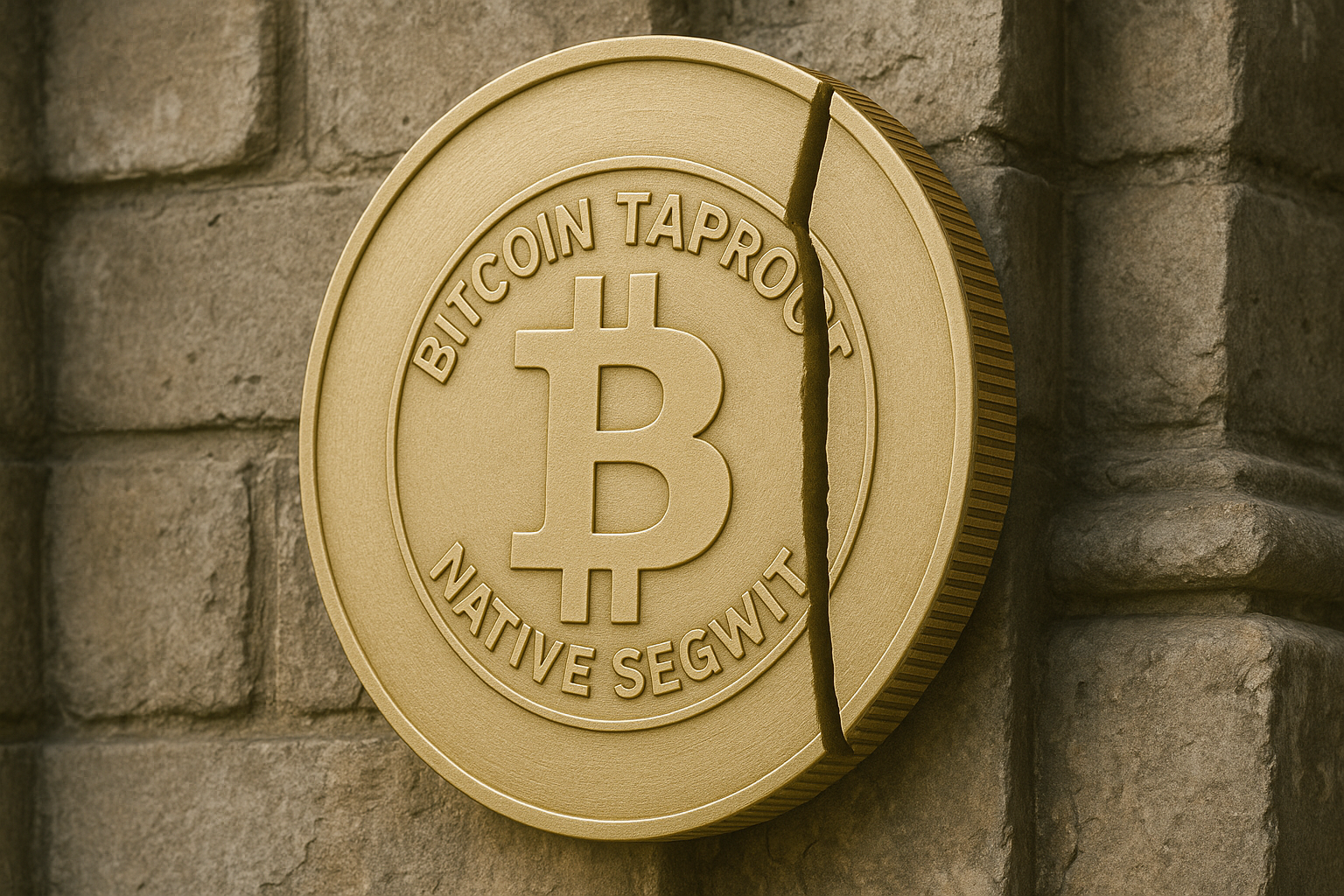15 Key Points (Taproot vs Native SegWit):
-
Native SegWit introduced in 2017; Taproot activated in 2021.
-
Native SegWit improves efficiency by separating signatures.
-
Taproot adds Schnorr signatures and MAST scripts.
-
Native SegWit widely supported; Taproot adoption growing.
-
Taproot enhances privacy, especially for multisig transactions.
-
Fees slightly lower for simple Taproot transactions; significantly lower for complex transactions.
-
Native SegWit addresses start with bc1q; Taproot addresses start with bc1p.
-
Taproot supports advanced smart contracts and complex scripts.
-
Both protocols coexist; no forced transition from Native SegWit to Taproot.
-
Taproot increasingly popular with institutions and DeFi apps.
-
Both address types legally compliant globally (2025).
-
Upcoming upgrades (CTV, SIGHASH_ANYPREVOUT) build upon Taproot.
-
Native SegWit ideal for everyday Bitcoin use.
-
Taproot privacy may impact local regulatory compliance (AML/KYC).
-
Experts predict rapid Taproot adoption by 2027, stabilizing alongside Native SegWit.
Understanding Bitcoin Taproot and Native SegWit – Foundations and Technical Differences
As Bitcoin has matured from a peer-to-peer payment concept into a robust financial infrastructure, it has undergone several technical upgrades designed to improve transaction efficiency, scalability, and privacy. Two of the most notable upgrades are Segregated Witness (SegWit) and Taproot — and understanding the difference between Taproot and Native SegWit is essential for developers, investors, and users alike.
What is Native SegWit (Bech32)?
Segregated Witness (SegWit) was introduced through Bitcoin Improvement Proposal 141 (BIP141) and activated on the Bitcoin mainnet in August 2017 1. Its main goal was to solve transaction malleability and improve scalability by separating the witness data (digital signature and script) from the transaction data 2.
There are two major forms of SegWit in use today:
-
Nested SegWit (P2SH‑SegWit): Uses addresses starting with “3”.
-
Native SegWit (Bech32 or P2WPKH/P2WSH): Introduced in BIP173, using addresses that begin with “bc1” 3.
Native SegWit offers multiple improvements:
-
More efficient block space usage compared to legacy and nested formats 4.
-
Lower transaction fees due to better byte‑to‑weight conversion in Bitcoin’s block weight system 5.
-
Enhanced error detection and human readability through Bech32 encoding 6.
It became popular due to its simplicity, backward compatibility, and reduced fees, making it ideal for most everyday Bitcoin transactions.
What is Taproot?
Taproot, activated in November 2021 7 , represents a more complex and powerful upgrade. It was implemented via BIP340, BIP341, and BIP342 8 and builds upon SegWit’s foundation to enable:
-
Schnorr Signatures: A replacement for ECDSA, offering better privacy and smaller signature sizes 9.
-
MAST (Merkelized Abstract Syntax Trees): Allows Bitcoin scripts to reveal only the executed path rather than the entire smart contract logic 10.
-
Tapscript: A new scripting language tailored for Taproot’s features, enhancing flexibility 11.
Taproot introduces a new address type: P2TR (Pay‑to‑Taproot), also using the “bc1” prefix, but distinguishable due to different format lengths and usage of Schnorr public keys 12.
| Feature | Native SegWit (Bech32) | Taproot (P2TR) |
|---|---|---|
| Address Format | bc1 (shorter, e.g., bc1q…) | bc1 (longer, e.g., bc1p…) |
| Signature Scheme | ECDSA | Schnorr |
| Script Type | P2WPKH / P2WSH | Tapscript with MAST |
| Multi‑sig Handling | Uses complex script exposure | Offers aggregated keys (MuSig2 potential) 13 |
| Fee Efficiency | High | Potentially higher in multi‑path scripts |
| Privacy | Limited over legacy | Significantly enhanced for complex spending 14 |
| Activation Date | 2017 | 2021 |
Taproot retains SegWit’s fundamental design (witness segregation, block weight model) but builds atop it with a future-ready scripting and privacy structure. In essence, Taproot is an upgrade that expands what Native SegWit made possible.
SegWit vs Taproot: Compatibility and Adoption
Native SegWit has seen widespread adoption across most Bitcoin wallets, exchanges, and payment processors 15. Many wallets like Electrum, Wasabi, and Ledger support Bech32 addresses by default 16. This broad adoption means that users can reliably transact with low fees and solid compatibility.
Taproot, being newer, has experienced slower but steady adoption. As of mid‑2025, support across hardware wallets and exchange platforms is rising, but not yet universal 17. Adoption is especially prominent among developers and institutions exploring Bitcoin’s smart contract capabilities or seeking enhanced privacy for complex transactions.
It’s also worth noting that Taproot is fully backward‑compatible with earlier Bitcoin addresses and standards 18. However, to use its features (e.g., Schnorr signatures or MAST scripts), both sender and receiver must support Taproot — a practical limitation that slightly slows its mainstream rollout 19.
Why These Differences Matter for Users
The choice between Native SegWit and Taproot depends on use case:
-
Everyday Users: Native SegWit remains the easiest and most efficient choice for regular Bitcoin transactions.
-
Developers and Institutions: Taproot opens new capabilities for privacy‑preserving smart contracts and scalable multi‑signature systems.
-
Future‑forward Users: Those expecting more advanced decentralized applications or Bitcoin‑based financial systems will find Taproot’s structure critical.
Privacy, Fees, Wallet Compatibility, and Real-world Use Cases of Taproot and Native SegWit

Bitcoin users often prioritize different features depending on their needs. Two of the most critical features include transaction privacy and fee efficiency. Understanding the nuances of how Taproot and Native SegWit address these points helps users make informed decisions based on practical considerations and real-world scenarios.
Privacy: Taproot vs Native SegWit
While Bitcoin is pseudonymous, transactions are traceable. Therefore, improvements in privacy protocols matter significantly to users.
Native SegWit improved privacy slightly over legacy formats by partially obscuring some transaction details, primarily by separating signatures from transaction data, thus reducing some transaction fingerprinting 20. However, Native SegWit still exposes multiple spending conditions or scripts when used in complex multi-signature transactions 21.
In contrast, Taproot significantly enhances privacy for advanced transactions through two primary innovations: Schnorr signatures and Merkelized Abstract Syntax Trees (MAST).
Schnorr Signatures allow multiple signatures to be aggregated into a single signature, obscuring the number of participants involved in multi-signature transactions 22.
MAST ensures that only the executed portion of a script is revealed, concealing alternative spending paths from external observers 23.
This combination drastically reduces the information available to blockchain analysts, greatly enhancing the privacy of complex transactions like multisigs, Lightning Network channel closures, or smart contracts 24.
Real-world Fee Comparison
Transaction fees depend significantly on the transaction size, measured in virtual bytes (vBytes). Smaller transactions result in lower fees.
Native SegWit transactions typically reduce transaction sizes by around 20–40% compared to legacy transactions, translating to noticeably lower fees 25.
Taproot transactions, when using single-signature spends, provide a similar fee structure to Native SegWit, slightly lower in many cases 26. However, Taproot achieves greater efficiency in complex multisignature or multi-path transactions, often significantly reducing costs due to Schnorr signature aggregation 27.
In real-world terms, everyday users transacting from simple wallets will notice only marginal differences between Native SegWit and Taproot. However, organizations and businesses using complex smart contracts or multi-party transactions may save significantly in fees by adopting Taproot 28.
Wallet and Exchange Compatibility in 2025
As of mid-2025, Native SegWit (Bech32) enjoys near-universal adoption among major wallet providers, including popular hardware wallets such as Ledger, Trezor, and software wallets like Electrum, BlueWallet, and exchanges such as Binance, Coinbase, and Kraken 29. This universal acceptance means that users face minimal friction using Native SegWit addresses in their day-to-day transactions.
Taproot, despite its activation in November 2021, still experiences slower but accelerating adoption rates among wallets and exchanges. As of mid-2025, popular wallets and exchanges including Ledger, Trezor Suite, Electrum, Kraken, and Binance have implemented or announced support for Taproot 30. However, certain smaller exchanges and wallet providers lag behind in supporting Taproot addresses, posing occasional compatibility hurdles for users 31.
For users prioritizing widespread acceptance and compatibility, Native SegWit remains the safest bet. Conversely, users and developers focused on advanced Bitcoin applications, privacy, or long-term fee savings will benefit from adopting Taproot despite occasional friction in acceptance.
Practical Real-world Use Cases: Native SegWit vs Taproot
Real-world scenarios clearly illustrate where each upgrade excels.
Daily Transactions and Payments: Native SegWit’s universal acceptance and straightforward functionality make it ideal for regular transactions such as remittances, retail purchases, or standard transfers 32.
Advanced Financial Instruments and DeFi: Taproot is becoming increasingly important in complex decentralized finance (DeFi) applications, facilitating secure, private, and efficient financial contracts. Bitcoin-based lending, collateralized loans, or advanced escrow services can utilize Taproot to maximize privacy and reduce fees 33.
Institutional Multi-signature Wallets: Businesses and institutions requiring multi-signature wallets gain significant advantages using Taproot. Enhanced privacy and cost savings through aggregated signatures make Taproot preferable for organizational treasury management and secure asset custody 34.
Legal Considerations and Risk Mitigation
Legally, both Taproot and Native SegWit are fully compliant with current regulatory frameworks across major jurisdictions (North America, Europe, Asia, etc.) as of 2025 35. Neither protocol inherently increases regulatory risk, though Taproot’s improved privacy does mean users must remain vigilant in their compliance with local anti-money laundering (AML) and Know Your Customer (KYC) requirements 36.
To mitigate risks associated with adopting either protocol, users should:
- Verify wallet compatibility before initiating transactions.
- Regularly update wallet software to leverage the latest security enhancements.
- Ensure compliance with local regulatory guidelines, especially for privacy-enhanced Taproot transactions 37.
Future Outlook and Expert Predictions (2025–2027)
Experts anticipate continued growth in Taproot adoption, particularly within financial institutions and Bitcoin-native applications. Taproot’s enhanced privacy and efficiency align well with growing demands for secure and scalable smart contract infrastructure on Bitcoin 38. By 2027, Taproot is predicted to achieve near-native SegWit levels of support across the Bitcoin ecosystem 39.
Practical Guide, Security Insights, Detailed Adoption Statistics, and Regional Analysis of Taproot vs Native SegWit (2023–2025)

Bitcoin users, developers, and businesses considering whether to use Taproot or Native SegWit must understand how to practically implement each, the security considerations involved, and the status of global adoption.
Step-by-Step Practical Guide: Setting up Wallets and Making Transactions
Below are explicit, easy-to-follow instructions for setting up wallets and performing transactions using both address types.
Setting Up a Native SegWit Wallet (Bech32)
- Choose a Compatible Wallet: Download a reputable wallet that supports Native SegWit, such as Electrum, Ledger Live, Trezor Suite, or BlueWallet 40.
- Create a New Wallet:
- Open the wallet app.
- Select “Create New Wallet” and choose “Native SegWit (Bech32).”
- Secure Your Seed Phrase: Carefully record and securely store your 12–24 word recovery phrase.
- Generate a Receiving Address: Click “Receive” to generate a new address starting with bc1q.
- Make Transactions:
- To send Bitcoin, paste the recipient’s Bech32 address into the “Send” field.
- Confirm details and transaction fees, then click “Send.”
Setting Up a Taproot Wallet (P2TR)
- Choose a Taproot-Compatible Wallet: Use wallets with full Taproot support, such as Electrum 4.2+, Ledger Nano X/S (firmware 2.1+), or Trezor Suite (22.12+) 41.
- Create a Taproot Wallet:
- Open the wallet software.
- Select “Create New Wallet” and explicitly choose “Taproot (P2TR)” or “bc1p” addresses.
- Secure Your Recovery Seed: Record and securely store the recovery seed offline.
- Generate Taproot Address: Click “Receive” to generate a new P2TR address starting with bc1p.
- Send Bitcoin:
- Paste the recipient’s Taproot address into the send field.
- Adjust and confirm transaction fees, then authorize sending.
Security Considerations: Taproot vs Native SegWit
Security-wise, both Taproot and Native SegWit share foundational Bitcoin protocol security. However, distinct considerations include:
- Native SegWit is battle-tested and widely considered highly secure due to extensive real-world usage and thorough auditing since 2017 42.
- Taproot has passed rigorous security audits since its activation but remains relatively new. The primary Taproot-specific security considerations revolve around correctly implementing Schnorr signatures and multi-party scripts. Incorrect implementations could expose vulnerabilities 43.
Best practices include always using audited wallet software and keeping firmware/software up-to-date to mitigate risks effectively.
Adoption Statistics and Market Analysis (2023–2025)
By mid-2025, Native SegWit dominates Bitcoin transactions with roughly 80–85% of all Bitcoin transactions globally using Bech32 addresses 44.
In contrast, Taproot adoption has grown steadily from around 1–2% in 2022 to approximately 12–15% of global Bitcoin transactions by mid-2025 45. Adoption acceleration is notable among institutional wallets, Bitcoin smart contract applications, and privacy-focused platforms. The trend suggests continued steady growth as wallets, exchanges, and Bitcoin infrastructure providers increase their support.
Regional Adoption Insights (2023–2025)
Regional insights into Taproot and Native SegWit adoption vary significantly worldwide:
- North America (USA & Canada): Early adopters of Taproot, especially institutions and tech-forward companies. Over 20% of transactions using Taproot by mid-2025 46.
- Europe (EU & UK): Strong adoption of both Native SegWit (85%+) and growing institutional Taproot adoption (10–15%), notably in Switzerland, Germany, and UK financial sectors 47.
- Asia (Japan, Singapore, South Korea): Rapid Native SegWit adoption (over 90%), while Taproot lags at about 8–10%, concentrated in financial hubs like Singapore 48.
- Latin America (Brazil, Argentina, El Salvador): High Native SegWit adoption (75%+). Taproot adoption is modest (5–7%), primarily driven by Bitcoin-friendly regulations in El Salvador 49.
- Middle East (UAE, Saudi Arabia): Growing interest in Taproot (around 5–8%), especially in UAE-based crypto exchanges and financial services 50.
- Africa (Nigeria, South Africa, Kenya): Native SegWit predominates (80%+), with lower Taproot adoption (2–4%), constrained by slower wallet and exchange updates 51.
- Australia and Oceania: High SegWit adoption (85%+), moderate but increasing Taproot use (~10%) driven by institutional interest in crypto infrastructure 52.
Global Practical Recommendations for Users
- For immediate convenience, everyday users globally should continue prioritizing Native SegWit.
- Institutional and enterprise-level entities, especially in North America, Europe, and tech-advanced regions of Asia, should strategically adopt Taproot for long-term operational benefits.
- Emerging regions should monitor global adoption patterns closely, gradually integrating Taproot as support becomes widespread.
Expert Predictions and Adoption Forecast (2025–2027)
Bitcoin experts predict that by 2027, global Taproot transaction volume will rise to about 40–50%, driven by increased institutional participation and expanding smart contract functionalities on Bitcoin 53. Native SegWit will remain prominent for everyday use but will gradually cede market share in complex transaction scenarios to Taproot.
Future Bitcoin Upgrades, Technical Roadmap, Alternative Solutions, and Frequently Asked Questions (2025–2027)

As Bitcoin continues to evolve, understanding what comes next beyond Taproot and Native SegWit is crucial for staying ahead. This final part comprehensively covers future potential upgrades, the technical roadmap, a comparative analysis with competing solutions, and answers to frequently asked questions.
Future Bitcoin Protocol Enhancements (Beyond Taproot)
Following Taproot, the Bitcoin community has already begun discussions and proposals for the next major updates aimed at scalability, security, and privacy. Notable enhancements expected in the 2025–2027 timeframe include:
- OP_CHECKTEMPLATEVERIFY (CTV): Proposed via BIP119, CTV would enable more secure covenants, enhancing Bitcoin’s programmability and scalability, enabling features like transaction batching and advanced smart contracts 54.
- SIGHASH_ANYPREVOUT (BIP118): Aims to significantly simplify Layer-2 protocols like the Lightning Network by enabling flexible signature types that can reference transactions more dynamically. This upgrade could greatly enhance Bitcoin’s scalability and payment efficiency 55.
- Cross-Input Signature Aggregation (CISA): Would extend Schnorr signatures, allowing aggregation of signatures across multiple inputs within a single transaction, drastically reducing transaction size and fees 56.
These updates represent the Bitcoin community’s clear trajectory toward improved transaction efficiency, advanced programmability, and heightened user privacy.
Bitcoin Technical Roadmap and Community Consensus (2025–2027)
Bitcoin upgrades follow a meticulous community-driven process, typically involving:
- Proposal via Bitcoin Improvement Proposals (BIPs).
- Thorough peer review, debates, and technical audits.
- Gradual testing on testnet before consensus-driven activation on the mainnet.
The Bitcoin community in 2025–2027 remains committed to conservative, security-first upgrades. Upcoming improvements such as CTV, SIGHASH_ANYPREVOUT, and CISA enjoy widespread conceptual support but require extended debate, testing, and rigorous audits to ensure security and decentralization remain uncompromised 57.
Alternative Privacy and Smart Contract Solutions: Comparative Analysis
While Bitcoin enhances privacy and smart-contract capabilities, other blockchain solutions offer distinct approaches worth noting:
- Ethereum and Layer-2 Rollups (e.g., Optimism, Arbitrum): Ethereum remains dominant in decentralized finance (DeFi) due to extensive smart-contract capabilities, although often at the cost of greater complexity and varying security assumptions 58.
- Monero (XMR): Provides enhanced transactional privacy through ring signatures, stealth addresses, and ring confidential transactions. However, Monero lacks Bitcoin’s broad acceptance and institutional adoption 59.
- Zcash (ZEC): Implements zk-SNARKs for zero-knowledge privacy. While technically sophisticated, Zcash struggles with broader adoption due to complexity and regulatory uncertainty 60.
Bitcoin’s focus remains on careful, incremental privacy and functionality enhancements that maintain its decentralization and robust security model.
Frequently Asked Questions (FAQs) and Clarifying Misconceptions
Here are explicit answers addressing common user misconceptions and queries regarding Taproot and Native SegWit:
- Q: Will Taproot replace Native SegWit entirely?
- A: No, both will coexist indefinitely. Taproot complements Native SegWit rather than replacing it, each serving distinct purposes.
- Q: Does using Taproot enhance privacy for simple transactions?
- A: Taproot significantly enhances privacy for complex multi-signature or script-heavy transactions. However, privacy gains for simple single-signature transactions are minimal compared to Native SegWit.
- Q: Are Taproot transactions always cheaper?
- A: Not always. Taproot transactions are particularly cheaper for multisig or complex scripting. For simple transactions, fees are roughly comparable to Native SegWit.
- Q: Is Taproot riskier to use due to its newness?
- A: Initially, slightly yes. However, by mid-2025, extensive audits and real-world usage have significantly mitigated risks. Users should nonetheless always employ updated, reputable wallet software.
- Q: Can I switch easily between Native SegWit and Taproot?
- A: Generally, yes. Most modern wallets allow users to switch address types. However, confirm your wallet’s compatibility before changing address types to avoid complications.
- Q: Is Taproot adoption mandatory?
- A: No, using Taproot is completely optional. Users and institutions adopt it based on specific privacy, fee-saving, or functional needs.
Clarifying Legal Concerns and Regulatory Risks (2025–2027)
Both Native SegWit and Taproot remain fully compliant and legally acceptable in major jurisdictions (North America, Europe, Asia, and others) by 2025. However, as global regulatory frameworks evolve, users employing privacy-enhancing features of Taproot should remain vigilant about compliance with local AML/KYC requirements 61.
Expert Predictions: Bitcoin’s Future (2025–2030)
Experts forecast continued incremental enhancements rather than radical protocol changes, reinforcing Bitcoin’s role as a secure global monetary standard. By 2030, features like Taproot, CTV, and signature aggregation could position Bitcoin as a versatile financial infrastructure layer supporting global finance, decentralized finance, and privacy-sensitive applications 62.
Adoption by institutions and nation-states is expected to rise significantly, potentially embedding Bitcoin even more deeply into global economic infrastructure.
Practical Recommendations for Users (2025–2027)
- Stay updated on Bitcoin community discussions through reputable sources like the Bitcoin Core development forum and trusted Bitcoin-focused platforms.
- Gradually adopt Taproot and related updates based on your privacy needs, institutional requirements, or operational efficiency.
- Regularly evaluate wallet and platform compatibility with emerging Bitcoin standards.
By remaining informed and prepared, users can confidently navigate Bitcoin’s evolution while maximizing its security, privacy, and economic advantages.
Disclaimer
This article is explicitly educational and not intended as financial or legal advice.



